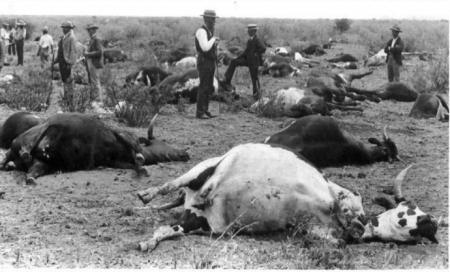The UN Food and Agriculture Organization will announce today that the cattle-plague Rinderpest has been officially eradicated from planet earth. This is a huge, huge achievement for humanity. Rinderpest cannot infect humans, but it has had a devastating effect on livelihoods for centuries — causing society-wide economic distress and starvation.
Back in October, when the FAO said they are preparing for the major Rinderpest announcement, I wrote the following:
Scientists from the Food and Agriculture Organization are reporting that a cattle plague that has been a drain on human economic and social development for hundreds of years has been wiped off the face of the earth.
This is a big deal.
Rinderpest, as it is known, is a virus that attacks cattle and other hoofed animals. It spreads quickly, causing swift death of infected cattle. Humans cannot contract Rinderpest, but they can–and have–suffered from its virulence. It has ruined livelihoods and indirectly resulted in the deaths of millions of people.
The disease has affected Europe, Asia and Africa for centuries and has caused widespread famine and decimated millions of animals, both domestic and wild. In the 1880s, rinderpest caused losses of up to one million head of cattle in Russia and central Europe,” said Diouf. When it entered Africa in the nineteenth century, it decimated millions of heads of livestock and wildlife and triggered widespread famine. It is estimated that in that pandemic alone, up to one-third of the human population of Ethiopia died of starvation as a result. The last known outbreak of rinderpest occurred in 2001 in Kenya.
The disease has been undetected since 2001 and the FAO will issue a formal declaration of “global freedom from rinderpest” sometime next year. When this happens, rinderpest will be the second virus to have been successfully eradicated by humans.
In 1980, after a 13 year global campaign lead by the UN, small pox was successfully wiped off the earth. In both cases, success was predicated upon the global coordination of activities that were implemented on the national and sub-national levels. In other words, the UN helped countries help themselves — and by helping themselves, they helped everyone else defeat this disease. This is global cooperation at its best.
Polio is next on the global hit list.
The World Health Organization launched the Global Polio Eradication Initiative in 1988. Twenty two years ago there were an estimated 350,000 cases of Polio. So far in 2010, there have been 717 confirmed cases, the vast majority of which are in just a few endemic countries. That is obviously a huge improvement, but it is not eradication. I suspect that polio will be gone before long. For one, The Bill and Melinda Gates Foundation is making it a priority. Where they go, the money, resources and political will tends to follow. But more importantly, the same international model used to destroy rinderpest and small pox is now being employed in the global fight against Polio. That model has worked twice before, so there is no reason to believe that it cannot successfully nudge Polio into the dustbin of history.

